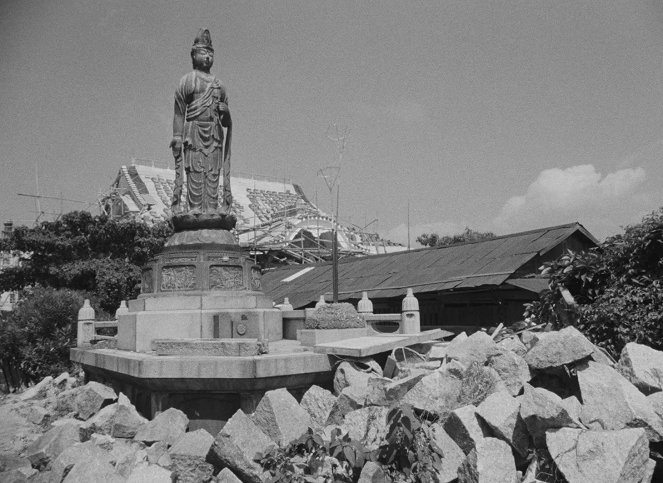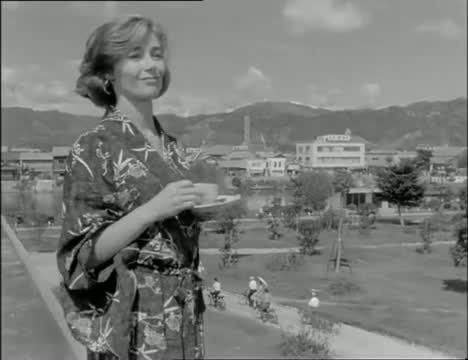VOD (2)
Plots(1)
Following Night and Fog, his devastating chronicle of the Nazi concentration camps, Resnais was asked to make a film about the atomic bomb, and responded with this moody masterwork, a love story in which a French actress (Emmanuelle Riva) and Japanese architect (Eiji Okada) exorcise their memories of war during a torrid affair amid the ruins of Hiroshima. (Umbrella Entertainment)
(more)Videos (1)
Reviews (3)
Hiroshima as artefact and illusion, Hiroshima as a symbol of suffering, rebirth and love that locks its protagonists in time and space. In the first half, I couldn't take my eyes off it and I enjoyed the fact that after a really long time I was watching an almost purely lyrical film that could speak deeply to the viewer and not just to itself. The second half, by contrast, offers only a biting romance in the Antonioni-style of "nocturnal wanderings through the city and cabarets" that, even with its groundbreaking intellectual ambitions, didn't touch me. Resnais has my respect, but he hasn’t earned my admiration yet.
()
A film told in non-present time. With the passage of fifty years after mind-game films (reconstructing the workings of certain thought processes with a varying degree of abstraction) became a common part of the mainstream, it is still fascinating to watch and hear how Resnais and Duras, influenced by Proust’s In Search of Lost Time and Griffith’s Intolerance fulfilled the producer’s request for a documentary about the atomic bomb. ___ In terms of content, the documentary-style prologue remains the most comprehensible part of this five-act film. It shows the direct, physical effects of the tragedy rather than the psychological consequences, which belong to the rest of the film – an essay on remembrance and forgetting, on personal and national traumas. One tragedy comes alive under the influence of another. The objective and subjective points of view overlap and become intertwined, similarly as in the opening shot of two bodies merging in an abstract painting (her Nevers, his Hiroshima – and vice versa). Here it is absolutely true that the form is the content. ___ The fluid transitioning between the past and the present, without the traditional visual “quotation marks” (e.g. a close-up of a face, the blurring of the image) leaves us in a state of uncertainty as to whether we are seeing flashbacks, imaginings or only the director’s illustration of the protagonist’s memories (i.e. a phenomenon that is not motived by the actual act of remembering). The transitions are initiated either at the level of personal experience or through the film’s form – sound, image and feeling. We do not know how what we see can be believed, just as in life we cannot rely on affective memory, which is constantly burdened by our knowledge of the past. The present recalls the past; the past helps to understand the present. Thanks to the dialectic relationship between the two timeframes, the film moves both forward and backward in parallel, in two directions and in two worlds at the same time. Memories emerge and suddenly vanish, the past merges with the present. People and places lose their identity, literally forgetting themselves. ___ The impression of an uninterrupted flow of images is enhanced by the lyrical off-camera commentary (which Duras used even more assiduously in her directorial debut, India Song) with lines repeated by the hypnotic voice of Emmanuelle Riva in the manner of a mantra, and Resnais’s stylistic trademark – long “disembodied” camera movements like those that he used in the documentaries Night and Fog and All the World’s Memory. ___ Hiroshima Mon Amour is not a unique film experience despite its incomprehensibility, but because of it, and though it bears some hallmarks of an overly intellectualised demonstration of what can be done with film (and to viewers), it also poses questions that pertain to every human being. When and where is our place in time? 80%
()
The first few minutes absolutely took my breath away. Alain Resnais utilizes documentary footage from Hiroshima, which shows just how destructive the nuclear bomb is, even on the people who didn't die but continue to live. However, under what conditions? Once you digest this, a story unfolds before you, which is also not entirely kind, although it can definitely be described as romantic. One of those films that leave something behind in you.
()
Gallery (36)
Photo © Cocinor



Ads